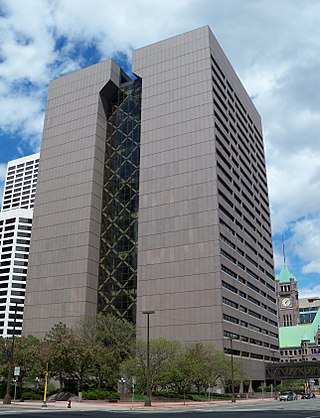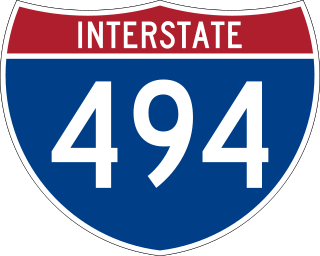Related Research Articles

A motel, also known as a motor hotel, motor inn or motor lodge, is a hotel designed for motorists, usually having each room entered directly from the parking area for motor vehicles rather than through a central lobby. Entering dictionaries after World War II, the word motel, coined as a portmanteau of "motor hotel", originates from the defunct lodging compound establishment; The Milestone Mo-Tel in San Luis Obispo, California, which was built in 1925. The term referred to a type of hotel consisting of a single building of connected rooms whose doors faced a parking lot and in some circumstances, a common area or a series of small cabins with common parking. Motels are often individually owned, though motel chains do exist.

Effigy Mounds National Monument preserves more than 200 prehistoric mounds built by pre-Columbian Mound Builder cultures, mostly in the first millennium CE, during the later part of the Woodland period of pre-Columbian North America. Numerous effigy mounds are shaped like animals, including bears and birds.
The Hocągara (Ho-Chungara) or Hocąks (Ho-Chunks) are a Siouan-speaking Native American Nation originally from Wisconsin and northern Illinois. Due to forced emigration in the 19th century, they now constitute two individual tribes; the Ho-Chunk Nation of Wisconsin and the Winnebago Tribe of Nebraska. They are most closely related to the Chiwere peoples, and more distantly to the Dhegiha.

Hennepin County is a county in the U.S. state of Minnesota. Its county seat is Minneapolis, the state's most populous city. The county is named for the 17th-century explorer Louis Hennepin. It extends from Minneapolis to the suburbs and outlying cities in the western part of the county. Its natural areas are covered by extensive woods, hills, and lakes. As of the 2020 census, the population was 1,281,565. It is Minnesota's most populous county and the 34th-most populous county in the U.S.; more than one in five Minnesotans live in Hennepin County. It is included in the Minneapolis–Saint Paul–Bloomington Metropolitan Statistical Area.

Dakota County is the third-most populous county in the U.S. state of Minnesota, located in the east central portion of the state. As of the 2020 census, the population was 439,882. The population of Dakota County was estimated to be 447,440 in 2023. The county seat is Hastings. Dakota County is named for the Dakota Sioux tribal bands who inhabited the area. The name is recorded as "Dahkotah" in the United States Census records until 1851. Dakota County is included in the Minneapolis–St. Paul–Bloomington, MN–WI Metropolitan Statistical Area, the sixteenth largest metropolitan area in the United States with about 3.71 million residents. The largest city in Dakota County is the city of Lakeville, the ninth-largest city in Minnesota and fifth-largest Twin Cities suburb. The county is bordered by the Minnesota and Mississippi Rivers on the north, and the state of Wisconsin on the east.

Mall of America (MoA) is a large shopping mall located in Bloomington, Minnesota. Located within the Minneapolis–Saint Paul metropolitan area, the mall lies southeast of the junction of Interstate 494 and Minnesota State Highway 77, north of the Minnesota River, and across the Interstate from the Minneapolis–Saint Paul International Airport. It opened in 1992, and is the largest mall in the United States, the largest in the Western Hemisphere, and the twelfth largest shopping mall in the world.

Minneapolis–Saint Paul is a metropolitan area in the Upper Midwestern United States centered around the confluence of the Mississippi, Minnesota, and St. Croix rivers in the U.S. state of Minnesota. It is commonly known as the Twin Cities after the area's two largest cities, Minneapolis and Saint Paul. Minnesotans often refer to the two together simply as "The Cities". The area is Minnesota's economic, cultural, and political center.

Bloomington is a city in Hennepin County, Minnesota, United States. It is located on the north bank of the Minnesota River above its confluence with the Mississippi River, 10 miles (16 km) south of downtown Minneapolis and just south of the Interstate 494/694 Beltway. The population was 89,987 at the 2020 census, making it Minnesota's fifth-largest city.

Maple Grove is a suburban city in Hennepin County, Minnesota, United States. The population was 70,253 at the 2020 census. making it Minnesota's 11th most populous city.

Portage is a city in and the county seat of Columbia County, Wisconsin, United States. The population was 10,581 at the 2020 census, making it the largest city in Columbia County. The city is part of the Madison Metropolitan Statistical Area.

Metropolitan Stadium was an outdoor sports stadium in the north central United States, located in Bloomington, Minnesota, a suburb of Minneapolis.

The Great Peace of Montreal was a peace treaty between New France and 39 First Nations of North America that ended the Beaver Wars. It was signed on August 4, 1701, by Louis-Hector de Callière, governor of New France, and 1300 representatives of 39 Indigenous nations.

The Ho-Chunk, also known as Hocąk, Hoocągra, or Winnebago are a Siouan-speaking Native American people whose historic territory includes parts of Wisconsin, Minnesota, Iowa, and Illinois. Today, Ho-Chunk people are enrolled in two federally recognized tribes, the Ho-Chunk Nation of Wisconsin and the Winnebago Tribe of Nebraska. Historically, the surrounding Algonquin tribes referred to them by a term that evolved to Winnebago, which was later used as well as by the French and English. The Ho-Chunk Nation have always called themselves Ho-Chunk. The name Ho-Chunk comes from the word Hocaagra meaning "People of the Sacred Voice". Their name comes from oral traditions that state they are the originators of the many branches of the Siouan language.
Holiday Inn is a chain of hotels based in Atlanta, Georgia and a brand of IHG Hotels & Resorts. The chain was founded in 1952 by Kemmons Wilson (1913–2003), who opened the first location in Memphis, Tennessee. The chain was a division of Bass Brewery from 1988-2000, Six Continents from 2000-03, and IHG Hotels & Resorts since 2003. It operates hotels under the names Holiday Inn, Holiday Inn Express, Holiday Inn Club Vacations, and Holiday Inn Resorts. As of 2018, Holiday Inn has hotels at over 1,100 locations.

Interstate 494 (I-494) is an auxiliary Interstate Highway making up part of a beltway of I-94, circling through the southern and western portions of the Minneapolis–Saint Paul metropolitan area in Minnesota. The 42.94-mile (69.11 km) road is coupled with I-694 at each end and composes more than half of the major beltway of the region. I-694/I-494 also act as loop routes for I-35E and I-35W.

Karl Theodore Francis Bitter was an Austrian-born American sculptor best known for his architectural sculpture, memorials and residential work.

The Shakopee Mdewakanton Sioux Community is a federally recognized, sovereign Indian tribe of Mdewakanton Dakota people, located southwest of Minneapolis and Saint Paul, within parts of the cities of Prior Lake and Shakopee in Scott County, Minnesota. Mdewakanton, pronounced Mid-ah-wah-kah-ton, means "dwellers at the spirit waters."

U.S. Highway 169 (U.S. 169) is a major north–south highway in the U.S. state of Minnesota, connecting the Minnesota River valley with the Twin Cities and the Iron Range. Much of the route is built to expressway or freeway standards.
Charlie's Cafe Exceptionale was a large and successful restaurant in downtown Minneapolis, Minnesota from 1933 to its closing on July 21, 1982. It was located at 7th Street and 4th Avenue South and has been called Minneapolis's "most talked-about dining establishment" during its existence. It was owned and run by Charles Saunders until his death in 1964, and after that by his widow Louise Saunders until 1982.(Saunders' original partner was Charles "the Finn" Herlin, who died shortly after the restaurant opened.) Among the notable diners at the restaurant were Bob Hope, Jack Dempsey, and President Richard Nixon. The annual "Charlie Awards", honoring restaurants, restaurant dishes, and restaurant staff in the Twin Cities Minneapolis–Saint Paul metropolitan area of Minnesota are named after the restaurant.
References
- 1 2 3 Reilly, Mark (10 April 2017). "Rod Wallace, builder of the Thunderbird Motel, dies". Minneapolis / St. Paul Business Journal. Retrieved 6 November 2020.
- ↑ "Bloomington History Timeline". Bloomington Historical Society. Retrieved 6 November 2020.
- 1 2 3 Lileks, James (10 May 2016). "A final farewell to Bloomington's iconic Thunderbird Motel". The Star-Tribune. Retrieved 6 November 2020.
- 1 2 Halter, Nick (28 March 2016). "Bloomington's former Thunderbird Motel faces the wrecking ball". Minneapolis / St. Paul Business Journals. Retrieved 6 November 2020.
- ↑ Halter, Nick (21 September 2018). "Bloomington ramps up efforts to sell Thunderbird Motel site". Minneapolis / St. Paul Business Journal. Retrieved 6 November 2020.